| ID |
Date |
Author |
Type |
Category |
Subject |
|
664
|
Thu Nov 20 13:54:34 2025 |
Tyler | Update | TCS | FROSTI A# Optimization and Mesh Convergence Analysis |
| Attached below are slides discussing FROSTI A# Irradiance optimization and mesh convergence analysis for penetration depth. |
| Attachment 1: Updates_11_19_2025-3.pdf
|

|
|
663
|
Thu Nov 20 13:03:58 2025 |
Cece Ochoa | Update | ELOG | CE Cavity Design Update |
| Update on grouping 0+8th Order Modes |
| Attachment 1: 11_20_update.pdf
|

|
|
662
|
Thu Nov 20 12:40:47 2025 |
Xuesi Ma | Infrastructure | General | Room 1125 Optical Table |
Cleaned off the tapes on the optical table with acetone. |
| Attachment 1: 1651.jpg
|
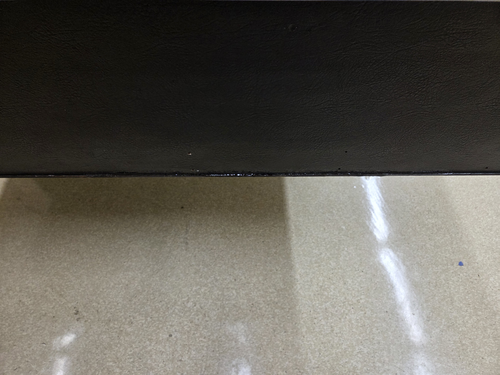
|
| Attachment 2: 1650.jpg
|
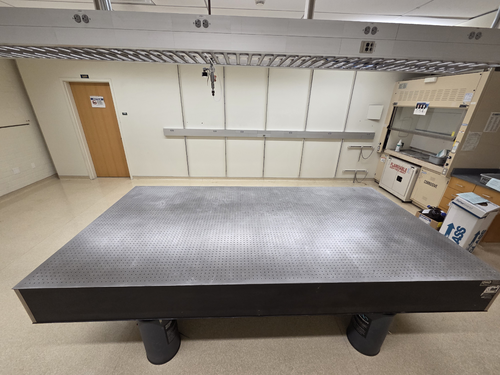
|
|
660
|
Thu Nov 13 12:39:01 2025 |
Mary | Update | Interferometer Simulations | |
|
| Attachment 1: PA.pdf
|

|
|
659
|
Thu Nov 6 12:39:43 2025 |
Cece Ochoa | Update | ELOG | CE Cavity Design Update |
| Updated mode placements and ROC. No thermal effects added yet. |
| Attachment 1: base_0_6_plot.pdf
|

|
| Attachment 2: base_0_7_plot.pdf
|

|
|
658
|
Thu Oct 30 11:45:44 2025 |
Liu | Update | Interferometer Simulations | Multi-ring FROSTI optimization for A# |
| Multi-ring FROSTI optimization for A#: dimensionality reduction with PCA vs. t-SNE |
| Attachment 1: Update.pdf
|

|
|
Draft
|
Thu Oct 23 11:34:05 2025 |
Michael | Update | Interferometer Simulations | Updated Exploration into Different SRC Mirror Configurations for Improved Squeezing |
|
| Attachment 1: Update_Slides_10_23_25.pdf
|

|
| Attachment 2: Update_Slides_10_30_25.pdf
|

|
|
656
|
Thu Oct 23 11:09:16 2025 |
Xuesi Ma | Update | Measuring Noise in Interferometer | Scatter Noise Model |
DetChar meeting presentation |
|
655
|
Thu Oct 23 10:07:51 2025 |
Liu | Update | Interferometer Simulations | Multi-ring FROSTI optimization for A# |
| 4D parameter space visualization and dimensionality reduction for better optimization |
| Attachment 1: loss_embedding.html
|
| Attachment 2: Update.pdf
|

|
|
654
|
Thu Oct 16 10:31:20 2025 |
Liu | Update | Interferometer Simulations | Multi-ring FROSTI optimization for A# |
| Two-ring FROSTI grid search with 4D parameter space search and visualization |
| Attachment 1: interactive_plot_dropdown.html
|
| Attachment 2: Update.pdf
|

|
|
653
|
Fri Oct 10 14:40:23 2025 |
Xuesi Ma | Update | VAC | Pressure gauge Swap |
[Tyler, Ma]
We suspect a pressure gauge problem. The electronic unit of the main chamber pressure gauge and the electronic unit of the RGA chamber pressure gauge are swapped.
Power and current draw aren't high for the turbo pump.
Before opening the gate valve, the pressure in the Main chamber is 2.98e-8 Torr, RGA Chamber 1.21e-5 Torr
After opening the gate valve (not fully open), the pressure in the Main chamber is 2.97e-8 Torr, RGA Chamber 1.55e-9 Torr. Note: the HV sensor suddenly turned on and the reading jumped to -9 Torr
Opening the gate valve a bit more, the pressure in the Main chamber is 2.98e-8 Torr, RGA Chamber 1.34e-9 Torr.
After switching the electronic unit, the pressure in the Main chamber is 3.23e-8 Torr, RGA Chamber 1.43e-9 Torr.
Gate Valve fully opened at 16:01 Oct 24, 2025 |
| Attachment 1: 1433.jpg
|
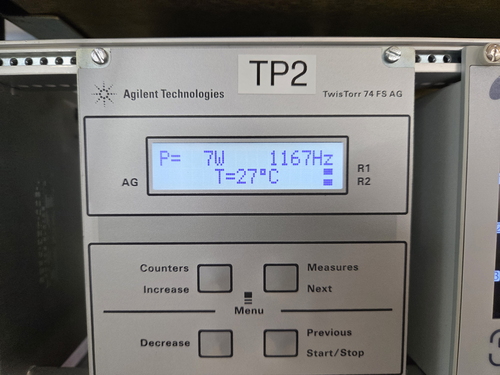
|
| Attachment 2: 1434.jpg
|
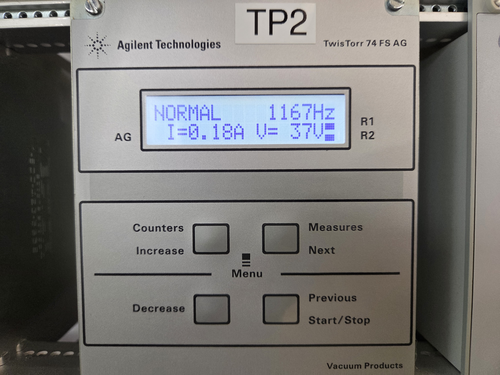
|
| Attachment 3: 1517.jpg
|
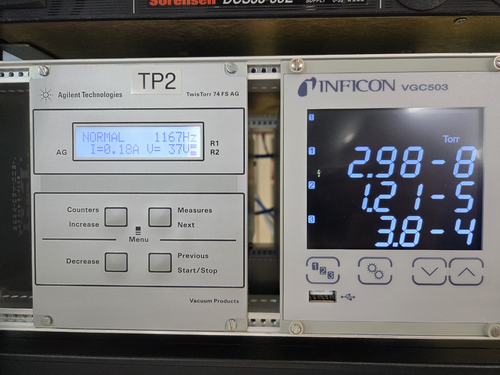
|
| Attachment 4: 1519.jpg
|
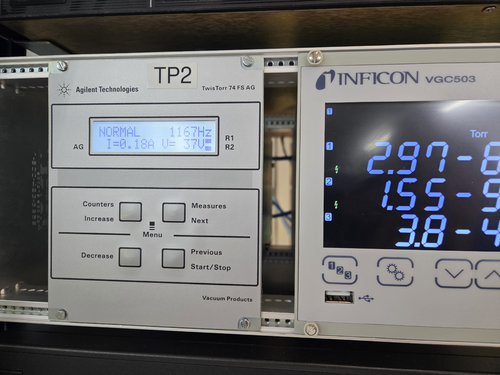
|
| Attachment 5: 1520.jpg
|
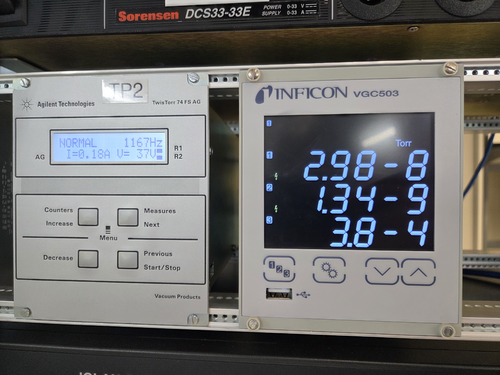
|
| Attachment 6: 1521.jpg
|
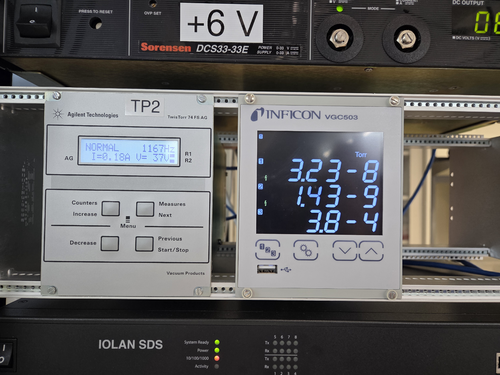
|
|
652
|
Thu Oct 9 12:18:14 2025 |
Liu | Update | Interferometer Simulations | Multi-ring FROSTI optimization for A# |
|
| Attachment 1: Update.pdf
|

|
|
651
|
Wed Oct 8 14:45:12 2025 |
Xuesi Ma | Infrastructure | VAC | RGA Chamber Pressure |
| RGA Chamber pressure is currently at 3.68e-4 torr. |
| Attachment 1: 20251008_130141.jpg
|
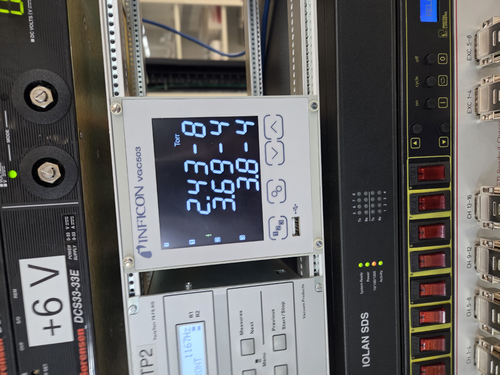
|
|
650
|
Tue Sep 30 12:51:23 2025 |
Tyler | Update | TCS | O6 RH Update 09/30/2025 |
| Slides |
|
649
|
Tue Sep 30 12:26:15 2025 |
Liu | Update | Interferometer Simulations | FROSTI optimization for A# |
|
| Attachment 1: Update.pdf
|

|
|
648
|
Tue Sep 23 13:10:07 2025 |
Tyler | Update | TCS | RH O6 Update 09/23/25 |
| Slides |
|
647
|
Tue Sep 23 12:39:29 2025 |
Liu | Update | Interferometer Simulations | Multi-ring FROSTI optimization for A# |
|
| Attachment 1: Update.pdf
|

|
|
646
|
Tue Sep 16 12:47:29 2025 |
Xuesi Ma | Update | Interferometer Simulations | Frosti actuation impact analysis |
| Slides |
|
645
|
Tue Sep 16 12:18:09 2025 |
Liu | Update | Interferometer Simulations | Grid search optimization for single-ring FROSTI |
| Grid search optimization for single-ring FROSTI |
| Attachment 1: Update.pdf
|

|
|
644
|
Tue Sep 9 13:08:44 2025 |
Xuesi Ma | Update | | |
| Slides |
|
643
|
Tue Sep 9 12:13:38 2025 |
Liu | Update | Interferometer Simulations | Multi-ring FROSTI optimization for A# with grid search |
| Multi-ring FROSTI optimization based on IFO metrics for A# with grid search |
| Attachment 1: Update.pdf
|

|
|
642
|
Tue Sep 9 12:06:38 2025 |
Tyler | Update | TCS | RH O6 Update |
| Slides |
|
641
|
Tue Sep 9 12:01:38 2025 |
Tyler, Ma | Update | | |
| Slides |
|
640
|
Tue Sep 2 18:33:38 2025 |
Liu | Infrastructure | General | New lab room 1125 layout and measurement |
Action items for facilities
- Ceiling lights replacement
- Fume hood cleaned and refurbished
- Sink countertop cleaning
- Floor cleaned and waxed
-
|
| Attachment 1: 1125.pdf
|

|
|
639
|
Tue Sep 2 12:41:33 2025 |
Liu | Update | Interferometer Simulations | Multi-ring FROSTI design for A# with ring heater optimization |
| [Tyler, Liu]
Ring heater optimization, continued |
| Attachment 1: Update.pdf
|

|
|
638
|
Tue Sep 2 12:34:02 2025 |
Xuesi Ma | Update | | Updata for self heating effect on HOM |
| https://docs.google.com/presentation/d/19I1fx5BLEzYb4Qnc9P4rJnYAvWI8NqE2dsj9gSPyYzg/edit?usp=sharing |
|
637
|
Tue Sep 2 11:53:34 2025 |
Tyler | Update | TCS | RIN Infrastructure Update (09/02/2025) |
| [Ma, Tyler]
Below are slides discussing RIN infrastructural updates related to the CyMAC.
Slides
|
|
636
|
Tue Aug 26 13:09:03 2025 |
Tyler | Update | TCS | O6 RH Update |
| [Tyler]
Below are slides giving an update on RH O6 design progress.
Slides |
|
635
|
Tue Aug 26 12:45:41 2025 |
Christina, Ma, Tyler | Update | CDS | RIN Update |
| Slides |
|
634
|
Tue Aug 26 12:18:36 2025 |
Michael | Update | Interferometer Simulations | Squeezing Plots for SRC Parameter Space |
| I've run a few plots of observed squeezing in the LIGO interferometer to fully ensure that the point we have selected is the optimal point for squeezing. Contrary to what I expected, there seems to be much more degenerate "optimal" configurations. While the toroidal case may be near optimal, it seems that the solution we found for a non astigmatic beam is not the only one. I will further explore this space to find more optimal/tolerant positions, which I see evidence of.
Additionally, as observed squeezing is computational expensive to compute, I found that the difference in round-trip gouy phase accumulation between the x and y planes is a good approximation for an optimal squeezing state, which I believe makes physical sense. This may be helpful to quickly compute other optimal conditions. |
| Attachment 1: Screenshot_2025-08-26_at_12-16-01_LIGO_Project_Log_-_Google_Docs.png
|

|
| Attachment 2: Screenshot_2025-08-26_at_12-16-32_LIGO_Project_Log_-_Google_Docs.png
|
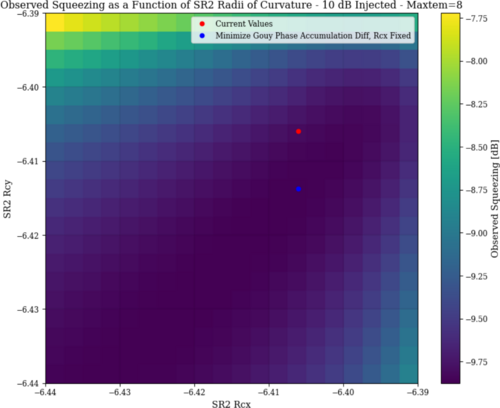
|
| Attachment 3: Screenshot_2025-08-26_at_12-17-26_LIGO_Project_Log_-_Google_Docs.png
|

|
|
633
|
Tue Aug 26 12:14:24 2025 |
Liu | Update | Interferometer Simulations | Multi-ring FROSTI design for A# with ring heater optimization |
| Multi-ring FROSTI design for A# with ring heater optimization |
| Attachment 1: Update_(1).pdf
|
.png)
|
|
632
|
Tue Aug 19 12:33:59 2025 |
Pooyan | Update | TCS | A# BS Update |
|
| Attachment 1: A#_beamsplitter_thermal_lensing.pdf
|

|
|
631
|
Tue Aug 19 12:08:40 2025 |
Christina | Update | TCS | RP Initial vs CyMAC Plot Comparisons |
| [Tyler, Ma, Christina]
These are the frequency averaged and veto binned plots for the initial Red Pitaya and CyMAC systems. |
| Attachment 1: 11hzCSD.png
|
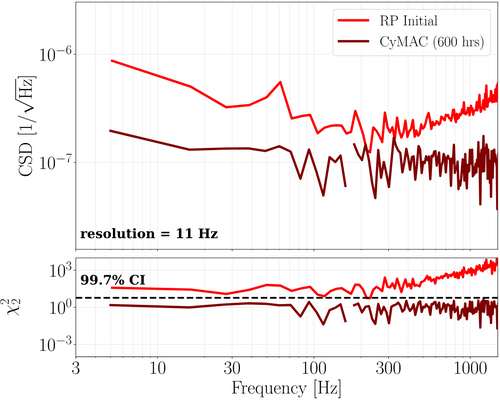
|
| Attachment 2: 11hzstrain.png
|
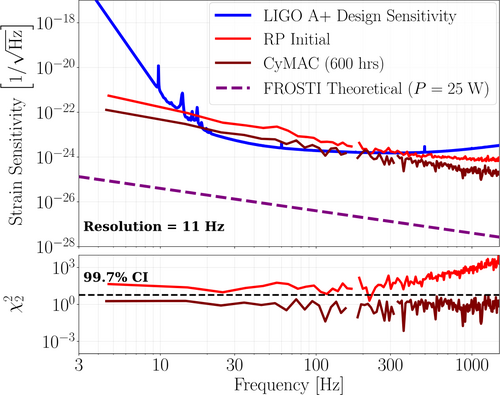
|
|
630
|
Tue Aug 12 13:49:24 2025 |
Mary | Update | | point absorber and coated aperture in A# |
|
| Attachment 1: Aug12.pdf
|

|
|
629
|
Tue Aug 12 13:46:56 2025 |
Christina | Update | | |
|
| Attachment 1: 3.png
|
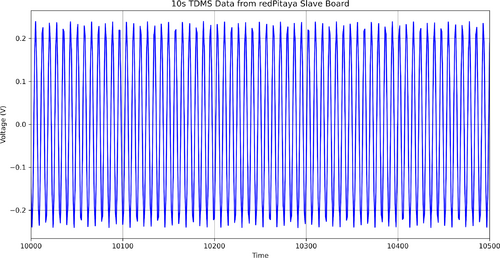
|
| Attachment 2: 3-1.png
|
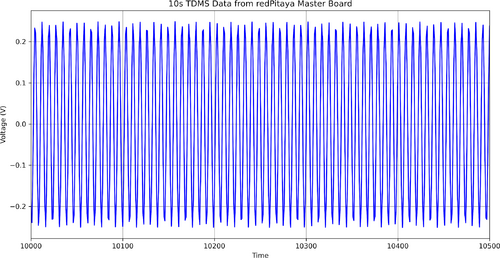
|
|
628
|
Tue Aug 12 13:32:43 2025 |
Liu | Update | Interferometer Simulations | |
| Differences in Fused Silica parameters. |
| Attachment 1: Screenshot_2025-08-12_at_1.31.11_PM.png
|
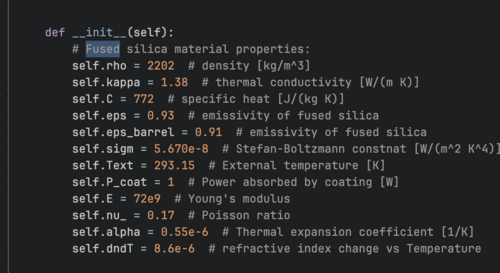
|
| Attachment 2: Screenshot_2025-08-12_at_1.31.17_PM.png
|
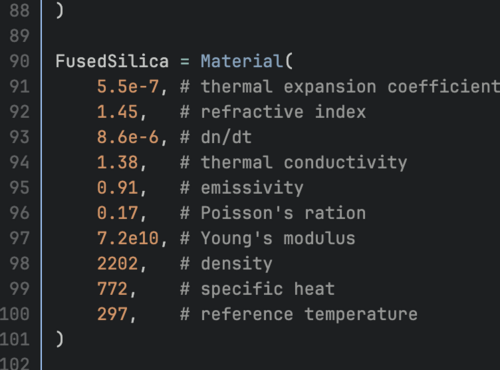
|
|
627
|
Tue Aug 12 13:28:00 2025 |
Tyler | Update | TCS | RH Fenicsx v. HV |
|
| Attachment 1: Profile_comparison.png
|
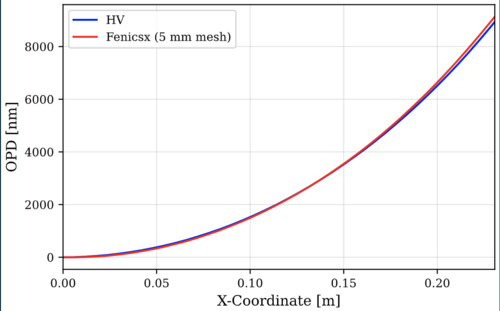
|
| Attachment 2: 1W_diff.png
|
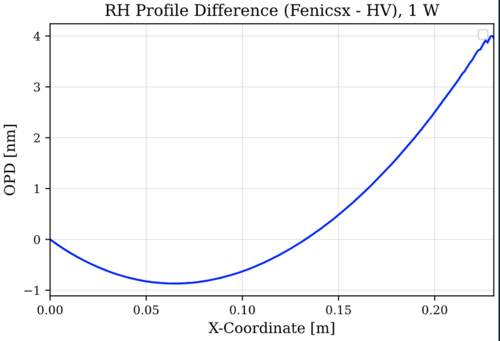
|
| Attachment 3: 50W_diff.png
|
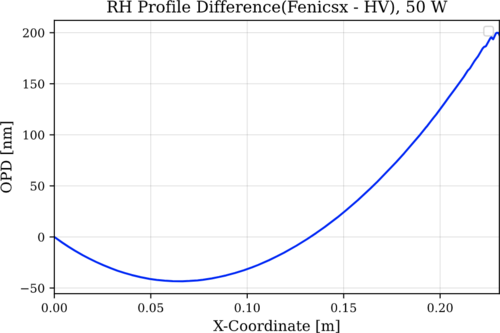
|
|
626
|
Tue Aug 12 12:35:19 2025 |
Tyler | Update | | CyMAC ADC Update |
| [Christina, Ma, Tyler]
Updated CyMAC measurement, comparing 260 hrs of measurement time vs. 405 hrs. |
| Attachment 1: CSD_magnitude.png
|
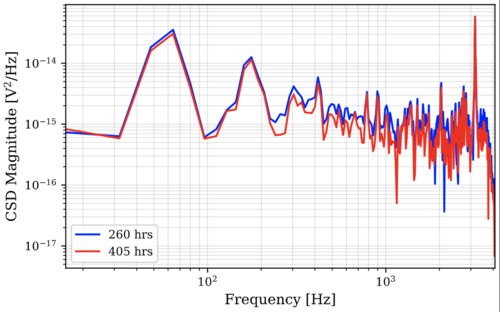
|
| Attachment 2: chi_sq.png
|
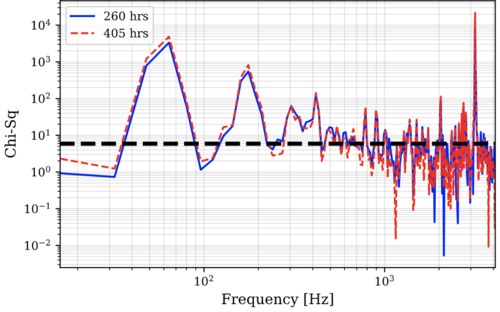
|
|
625
|
Tue Aug 12 12:16:21 2025 |
Liu | Update | Interferometer Simulations | Multi-ring FROSTI optimization for A# |
| Multi-ring FROSTI optimization for A# with static polishing |
| Attachment 1: Update.pdf
|

|
|
624
|
Mon Aug 11 22:19:50 2025 |
Christina | Update | TCS | Red Pitaya Data Streaming |
[Ma, Tyler, Christina]
This past week, we were able to set up the data streaming for continuous acquisition to the PCs, and can conduct the initial tests now. We were able to do this by:
- Installing the correct OS ecosystems to each Red Pitaya
- Installing the terminal streaming client
- Debugging formatting and file saving issues by saving the data in a TDMS file on the host PC.
We have started streaming the ADC data on Monday from both boards for 2 days, which are currently in the clean room. Below are the ADC tests we performed before starting the 2-day run. (Time in ms) |
| Attachment 1: 3.png
|

|
| Attachment 2: 3-1.png
|

|
|
623
|
Wed Aug 6 16:31:37 2025 |
Xuesi Ma | Update | | |
|
Date and Time: Around 4:20 PM on Auguest 6, 2025
Location and Temperature:
- Back of the room 1119, around the working station: 90.2 °F
- Front of the room 1119, around the doorway: 85.8 °F
- Back of the room 1129, around the working station: 93.4 °F
- Front of the room 1119, around the doorway: 82.3 °F
- In the hallway in front of room 1119: 77.2 °F
|